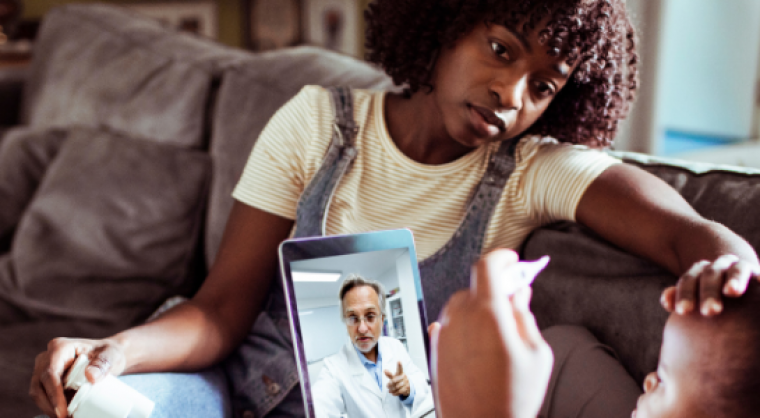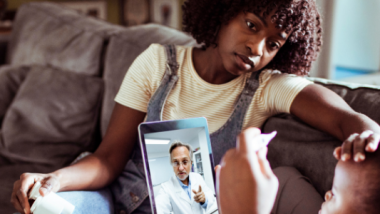
Amy Winkelman
System director, telehealth product development, Providence St. Joseph Health. Providence is the third largest non-profit health system in the U.S. with 51 hospitals, more than 800 clinics and a comprehensive range of health and social services across Alaska, Washington, Montana, Oregon, California, New Mexico and Texas
Telehealth exploded into the public consciousness this year as a way for clinicians and patients to safely connect during the COVID-19 crisis. While telehealth has been part of care delivery at Providence St. Joseph Health (PSJH) for more than a decade, it transitioned almost overnight from an offering most often focused on serving patients in rural areas, to a way for any patient to get the care they need virtually whether in a hospital, outpatient facility, or from the comfort and safety of their own home.
Telehealth growth was fueled by changes in regulation and reimbursement during the Public Health Emergency (PHE) enabling providers to see new and established patients at home across all payer types. To put this growth into perspective, PSJH averaged a few thousand video visits per month in January and February 2020. As COVID transmission spread and lockdowns began, that number climbed to over 15,000 video visits in March up to a height of more than 150,000 video visits in May. By the end of October, PSJH has conducted more than 1.2 million video visits, steadily accounting for 20-25% of total visit volume.
Gastroenterology went virtual
Providence St. Joseph Health gastroenterology providers have been a part of this wave, conducting more than 12,000 video visits so far this year (as documented in our Epic EMR), which has been an entirely new method of care delivery for the majority of these clinicians. We also have a large number of affiliated, private practice gastroenterology providers who practice in our facilities and transitioned quickly to video for outpatient care. Pre-procedure and post-procedure follow-up visits were some of the most common visit types that went virtual, along with new patient visits to establish care and existing patient visits to check in on the status of a health condition, medication or other concern. Complementary services for gastroenterology patients were transitioned to video over the past eight months as well. Care management, nutrition services, online support groups, bariatric care information sessions, behavioral health and more are now available for patients to access virtually.
It’s not about the tech
New technologies can be challenging to adopt – especially at such a rapid pace as was the case this year. Fortunately for PSJH, we had inpatient and outpatient video platforms already in place and an experienced internal telehealth team to scale them quickly to providers and caregivers across system. But even with those advantages, it was still a huge challenge to transition so many providers and caregivers to video visits in such a short time without change management hurdles and bumps along the way.
Too often, there is an overemphasis placed on the technology. It’s a tool, and some are better than others and they continue to evolve over time. True success or failure lies in the clinical and operational workflows and how well the providers and care teams engage with and adapt them. We found that the providers and staff members willing to venture outside their comfort zone of “how we’ve always done it” and collaborate on the transition to virtual care had the best results. Openness and flexibility to try things and using temporary workarounds if existing functionality didn’t meet the need was key to going fast. Then, by listening, sharing ideas and feedback across providers, clinics and geographies we were able to identify fixes and optimizations that needed to be made to improve the experience for all.
Selecting a video visit platform
No telehealth platform is perfect and meets every patient, provider and staff need or request despite what a technology vendor may claim. This is especially true in a large and/or diverse system with many different types of clinical use cases. Identifying the “must have” requirements vs. those that may be important or simply nice to have is critical when selecting the video visit platform to use.
It’s not an easy decision and nearly impossible to please everyone. Ensuring that there are clinician, operator and technical stakeholders all contributing to the requirements and decision making is essential. While some may prefer a “best of breed” solution that does one thing very well, it may have to be paired with a set of other complimentary applications to meet all of the organization’s needs. Alternatively, there may be a platform with an expansive feature set but not all of the features are as strong as desired. Then there are solutions that integrate with your existing applications, which is a compelling option to consider. Regardless of the tool chosen, best practice workflows, easy-to-follow documentation, a mix of different training options and internal technical help that’s quick to respond is key to implementing it successfully. And once implemented, optimization is an ongoing process to make it easier, faster, better.
Video visit platform evaluation categories:
- Security and privacy
- Cost
- Patient usability
- Provider and care team usability
- Ease of implementation and configuration
- Integration with other applications or platforms
- Administrative and reporting
- Vendor viability and experience
- Technical support













